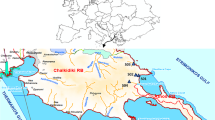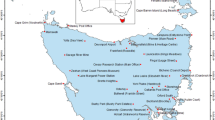Abstract
The accurate prediction of the extreme rainfall is of great interest in geology to make provision for nature events such as landslide. The extreme value theory is widely used to predict the daily extreme rainfall probability. In this study, we introduce a new extreme value model based on the Kumaraswamy generalized-Pareto distribution by applying it to peaks-over-threshold method. This method is shortly denoted as POT-KumGP. The extreme rainfall modeling accuracy of the POT-KumGP model is compared with a POT-GP model by means of a real data modeling on the daily rainfall data of Hopa region located in Artvin province of Turkey. The empirical results show that the POT-KumGP model produces more accurate results than POT-GP model based on the model selection criteria and result of goodness-of-fit test.







Similar content being viewed by others
References
Altun E (2019) The log-weighted exponential regression model: alternative to the beta regression model. Commun Stat-Theory Methods, pp 1–16
AghaKouchak A, Nasrollahi N (2010) Semi-parametric and parametric inference of extreme value models for rainfall data. Water Resour Manag 24(6):1229–1249
Balkema AA, De Haan L (1974) Residual life time at great age. Ann Probab 2(5):792–804
Ban N, Rajczak J, Schmidli J, Schär C (2020) Analysis of Alpine precipitation extremes using generalized extreme value theory in convection-resolving climate simulations. Clim Dynam 55(1):61–75
Can T, Nefeslioglu HA, Gokceoglu C, Sonmez H, Duman TY (2005) Susceptibility assessments of shallow earthflows triggered by heavy rainfall at three catchments by logistic regression analyses. Geomorphology 72(1-4):250–271
Castillo E, Hadi AS, Balakrishnan N, Sarabia JM (2005) Extreme value and related models with applications in engineering and science. Wiley-Interscience, Hoboken, N. J
Cordeiro GM, de Castro M (2011) A new family of generalized distributions. J Stat Comput Simul 81(7):883–898
Embrechts P, Klüppelberg C, Mikosch T (2013) Modelling extremal events: for insurance and finance, vol. 33. Springer Science & Business Media, New York
Ghosh S, Das D, Kao SC, Ganguly AR (2012) Lack of uniform trends but increasing spatial variability in observed Indian rainfall extremes. Nat Clim Chang 2(2):86–91
Guzzetti F, Ardizzone F, Cardinali M, Galli M, Reichenbach P, Rossi M (2008) Distribution of landslides in the upper tiber river basin, central Italy. Geomorphology 96(1-2):105–122
Hayek A, Khraibani Z, Radwan D, Tabaja N, Andaloussi SA, Toufaily J, Garnier-Zarli E, Hamieh T (2020) Analysis of the extreme and records values for temperature and precipitation in Lebanon. Commun Stat Case Stud Data Anal Appl, pp 1–18
Korkmaz MC, Altun E, Yousof HM, Afify AZ, Nadarajah S (2018) The burr X Pareto distribution: Properties, applications and VaR estimation. J Risk Financ Manag 11(1):1
Leadbetter MR, Lindgren G, Rootzén H (2012) Extremes and related properties of random sequences and processes. Springer Science & Business Media, New York
Li Y, Cai W, Campbell EP (2005) Statistical modeling of extreme rainfall in southwest Western Australia. J Clim 18(6):852–863
Langousis A, Carsteanu AA, Deidda R (2013) A simple approximation to multifractal rainfall maxima using a generalized extreme value distribution model. Stoch Env Res Risk A 27(6):1525–1531
Miniussi A, Marani M (2020) Estimation of daily rainfall extremes through the metastatistical extreme value distribution: Uncertainty minimization and implications for trend detection. Water Resour Res, vol 56 (7)
Nadarajah S (2005) Extremes of daily rainfall in West Central Florida. Clim Chang 69(2-3):325–342
Nadarajah S, Eljabri S (2013) The kumaraswamy gp distribution. J Data Sci 11(4):739–766
Nguyen HT, Wiatr T, Fernändez-Steeger TM, Reicherter K, Rodrigues DM, Azzam R (2013) Landslide hazard and cascading effects following the extreme rainfall event on Madeira Island (February 2010). Nat Hazards 65(1):635–652
Pickands J (1975) Statistical inference using extreme order statistics. Ann Stat 3(1):119–131
Resnick SI (2013) Extreme values, regular variation and point processes. Springer, New York
Towler E, Rajagopalan B, Gilleland E, Summers RS, Yates D, Katz RW (2010) Modeling hydrologic and water quality extremes in a changing climate: A statistical approach based on extreme value theory. Water Resour Res, vol 46 (11)
Author information
Authors and Affiliations
Corresponding author
Additional information
Communicated by: H. Babaie
Publisher’s note
Springer Nature remains neutral with regard to jurisdictional claims in published maps and institutional affiliations.
Rights and permissions
About this article
Cite this article
Tekin, S., Altun, E. & Çan, T. A new statistical model for extreme rainfall: POT-KumGP. Earth Sci Inform 14, 765–775 (2021). https://doi.org/10.1007/s12145-021-00581-x
Received:
Accepted:
Published:
Issue Date:
DOI: https://doi.org/10.1007/s12145-021-00581-x




